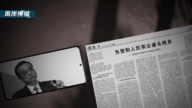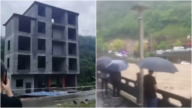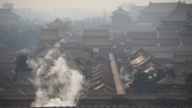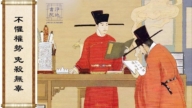【新唐人2012年9月4日讯】最近,有消息指称,多年前被中共国家发改委批示,一律暂停的煤制油项目,有死灰复燃的迹象。业内人士估计,待审批金额可能达到7000亿人民币。过去煤化工业在大陆的过渡发展,对环境污染、水资源的浪费早已备受争议。舆论认为,这是当局又一次为地方财政收入、拉台GDP的短视作为。
2008年9月,中共国家发改委发布的《关于加强煤制油专案管理有关问题的通知》中,明确要求各地区加强煤制油专案的管理。当时,除了“神华集团”的两大煤制油专案外,一律停止实施其他煤制油专案。目前,这则通知在网页上已被删除,但网上仍留有不少相关报导。
另外,中共国务院办公厅在隔年5月发布的《石化产业调整和振兴规划》中,对煤化工技术和专案准入方面规定“禁止核准或备案;按照有关规定严格实行核准制”。
不过,最近内蒙古“伊泰煤炭公司”总经理葛耀勇向《中国经营报》透露,目前,中共国家发改委等相关部门,正在审批“伊泰”投资建设的200万吨煤制油专案,预计将很快获得审批。报导还说,在内蒙古、新疆等多个省区,共计金额可能达到7000亿人民币的新型煤化工专案,也在等待评审。
四川高级工程师范晓认为,除必需考虑环境容量问题之外,中国还存在这些大项目的投入并非以实际需求来考量;更多原因是地方当局从中获得短期的利益,包括税收、GDP、拉动地方财政收入。
四川高级工程师范晓:“包括煤电规模,不光是煤电,现在很多基础设施,基础的能源的投资,它是不是需要这么大的规模,这本身就是有疑问的。就是,在最近的十几年,包括未来的十几年或者几十年,整个能源投资预期的,未来增长的提供能源的规模,现在提供的这些能源建设项目,它是远远超过实际的需求的。”
据了解,传统煤化工存在能耗高、污染重、规模小、工艺技术落后问题,在“十一五”期间就产能全面过剩。而新型煤化工由于耗水严重,导致原本“多煤少水”的西部面临更严重的水危机。
美国“南卡罗莱纳大学”教授谢田:“这个项目它有很多问题,首先,它要大量的政府补贴;但是,这项目本身如果耗水耗得那么高,技术又不成熟,很可能就是一种巨大的浪费,投入太高的话,实际上就没办法真正的商业化,可能就永远收不回来成本,又变成巨大的财务窟窿。我觉得是,中国经济下行、经济停滞给政府带来的压力太大了。实际上,现在有点饥不择食,找到这种项目,就开始要匆促的草率的上马。”
报导中,“上海华然投资咨询公司”研究员赵辰介绍,从综合行业的平均水准观察,目前生产一吨煤制油的耗水量约为9吨﹔煤制烯烃约为20吨﹔煤制二甲釄约为12吨。如此看来,煤化工的高耗水是最大的隐忧和软肋。
范晓:“实际,这个水资源是不能满足的,那么,必然会影响整个水资源供应的危机。反过来对水,对大气环境也会产生污染。从经济方面它也是有隐患的,因为,能源也会受到市场波动的影响。就以煤炭来说,最近一年多煤炭的价格下跌的非常厉害,从长远来看肯定会有很沉重的经济负担在里面。”
污
目前,多家煤化工项目都将水源盯住了黄河。国际环保组织绿色和平、“中国科学院地理科学与资源研究所”8月14号联合发布的研究报告中说,“十二五”期间计划在山西、陕北、内蒙、新疆、河南、云贵等地,打造煤电一体化开发建设的16个西部大型煤电基地,每天用掉的水,将是北京城区日供水能力的9倍。
这些正待审批的项目已受到中国各界人士的关注。民间环保人士陈云飞指出,这又是一个未经民意,没有征询真正专家评估;各地当局利益团体瓜分资源的一次组合。而事实上,有目共睹的是,自从中共统治大陆至今,搞了多少这类的专案,带来不计后果的环境污染问题。
采访编辑/梁欣 后制/李月
Suspended Coal-to-Chemical Projects in China Comes Back
China has reportedly seen a revival of
Coal-to-liquids (CTL) projects,
which were suspended many years ago
by the Chinese Communist Party (CCP) regime.
Industry insiders estimate the projects awaiting
approval may involve RMB 700 Billion.
Excessive development of China’s coal chemical industry
has long been controversial for its pollution and water waste.
Commentators say it is another shortsighted action taken
by local authorities for fiscal revenue and pull GDP figure.
On September 2008, the CCP’s National Development
and Reform Commission (NDRC) issued a notice.
The notice strengthened regulation of CTL projects.
The regime ordered all CTL projects to stop
in China, except the two under Shenhua Group.
The notice has now been removed from the webpage,
but lots of related news reports are still accessible online.
In May 2009, the General Office of the CCP’s State Council
released a plan to restructure the petrochemical industry.
The plan stated, “prohibit the approval or filing” of
market access for coal-to-chemical technology and projects.
Recently, China Business Journal reported news about
the coal liquefaction project of Inner Mongolia Yitai Group.
Yitai’s 2-million-ton CTL project is reportedly waiting NDRC
approval, and is expected to get the green light soon.
The news said there are coal-to-chemical projects awaiting
approval that involve investment of RMB 700 Billion.
These neo-type projects are located
in Inner Mongolia, Xinjiang and other regions.
Sichuan-based senior engineer Fan Xiao says that
environmental capacity is a must factor to be considered.
Fan Xiao comments that the CCP regime approving such
large projects is not based on the actual demand.
Short-term interests that can benefit local authorities are
the main reason behind the approval, said Fan Xiao.
These benefits include tax, GDP,
local fiscal revenues, etc.
Fan Xiao: “A lot of existing basic resource projects, like coal
and power, has been brought into question in large scale.
In the next decade or so, China’s investment
in energy has far exceeded its needs, in reality.”
Traditional coal-to-chemical projects are known
as high energy consumption, heavy pollution, small scale and obsolete technologies.
Back in the period of 2006-2010, China had
excess capacity in the coal-to-chemical industry.
The late-model coal-to-chemical
projects have high use of water.
This caused a more serious water crisis in Western China,
where there are abundant coal deposits but lack of water.
Xie Tian, Professor, University of South Carolina:
“This project shows a lot of problems.
Firstly, it’s greatly subsidized by the government, and
has such high water usage and immature technology.
If it is invested in heavily, it’s very likely to be a huge waste.
So it cannot really be commercialized, and would probably
never cover its cost. That would be a huge financial hole.
In my view, China’s economic downturn and stagnation
has put too much pressure on the regime.
Now it’s not choosy about its food. Once the project
looks favorable, it will rush hastily to launch it.”
A research fellow at a Shanghai-based investment
consulting firm revealed data to the China Business Journal.
On average, the production of 1 ton
of CTL uses about 9 tons of water.
1 ton of coal to olefins needs about 20 tons of water.
1 ton of the coal-based dimethyl
ether uses some 12 tons of water.
High water usage is coal-to-chemical
industry’s biggest problem.
Fan Xiao: “There is no infinite supply of water resources.
That’s bound to cause a water supply crisis.
In return, it pollutes water resources
and the atmospheric environment.
It also poses potential risks for the economy,
as energy can be easily affected by market fluctuation.
For example, the price of coal
has slumped in the last one year.
So in the long run, heavy financial cost
will be hidden inside these projects."
A number of coal-to-chemical projects have
pegged the Yellow River as their water source.
A joint research report was released on August 14
by Greenpeace International and the Institute
of Geographic Sciences and Natural Resources
Research, Chinese Academy of Sciences.
It states that in China’s official “12th Five-Year Plan",
16 large coal power stations are to be constructed.
They will be located in Western China, with the daily
use of water at nine times the supply capacity in Beijing.
The projects awaiting official approval
have aroused public concerns in China.
Environmental activist Chen Yunfei remarked
that these projects form “another portfolio”.
It is “another portfolio” without seeking
public opinion, nor real expert assessment.
It is “another portfolio” that is divided up among local
authorities and interest groups, said Chen Yunfei.
In reality, since the CCP took rule of China,
the country has existed in the pollution caused by so many of these kinds of project.




























